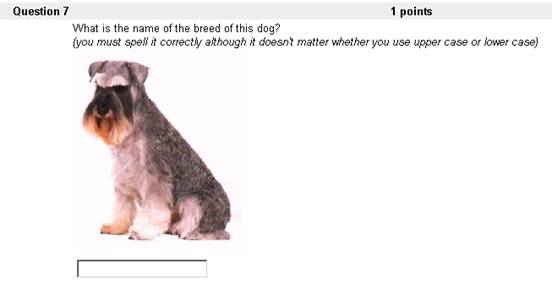Free response questions and variants
Our final category of questions is those where the student is not presented with a choice, but is shown a blank box into which text or numbers are entered.
Fill in the blank
Here the student types in one or two words as text:
A fill in the blank, or text entry question
|
This style of question gets us round the problem we saw earlier where the student has only to recognise an item from a list rather than retrieve it from their memory. However they need to be treated with great care; it must be clear and unambiguous what answer is required and the range of possible answers must be very limited. For this reason this question is well suited to use with images, for names, definitions etc. |
The other difficulty is that the student may know the answer but misspell it for some reason. It is therefore necessary to anticipate possible alternative spellings. Some assessment software is also able to allow for misspellings. However it may be that for the reasons given above free text questions are not suitable for high stakes exams, where it would be unfair to penalise the student for a mistake in entering the answer. |
HotspotA hotspot question is a question where the student has to select the correct area of an image. This can be by dragging a pointer to the correct place, or by clicking the mouse over the correct area. Some hotspot questions give no indication of where the hotspot might be. In this sense it falls into the free text category because it requires a completely free response rather than selecting from a list of options. Follow the link to see an example of a hotspot question of this type in action: However some hotspot style questions are actually multiple choice style, where they require the student to select from several highlighted areas on the image. |
Essay questionThe final type of free response question is an essay style question, where the response is an extended piece of writing, usually a paragraph or so. Here the computer is not able to mark the response, but can act as a medium for communicating the response to the marker, communicating feedback, and for storing the results. Numerical entry questionA numerical entry question is similar to a free text question except that it requires a number rather than a word, and does not suffer from the same risks of interpretation and misspellings associated with the text entry question. A further advantage is that some systems allow a proportion of marks to be given for any response entered within a set numerical range. |



